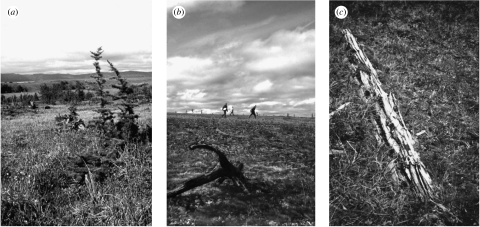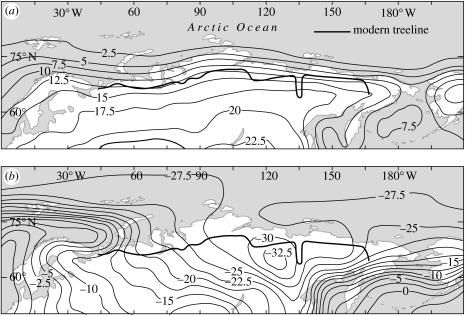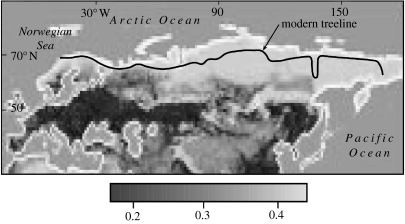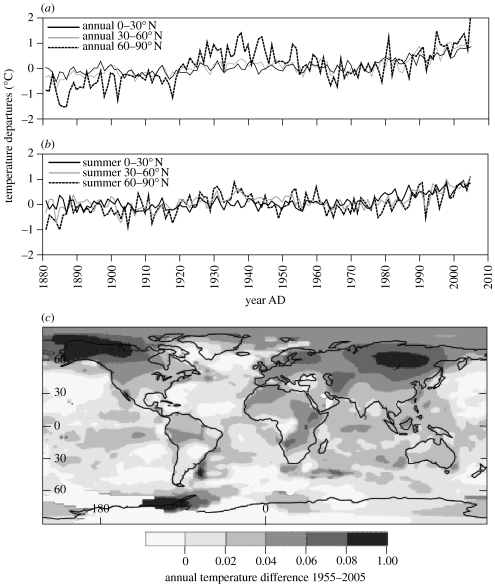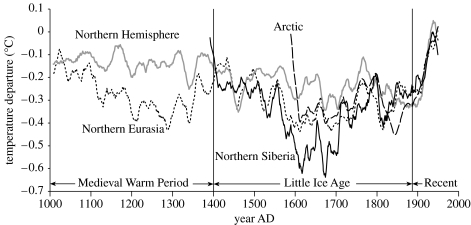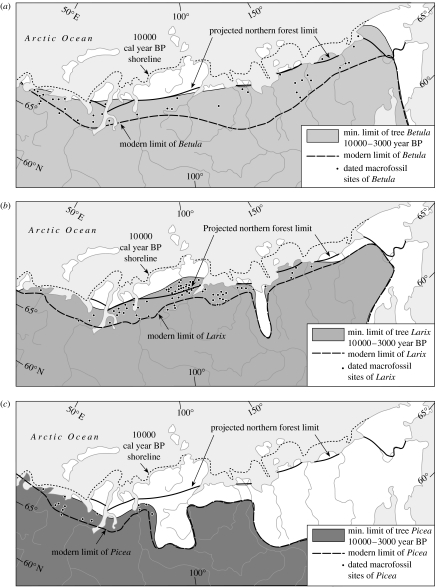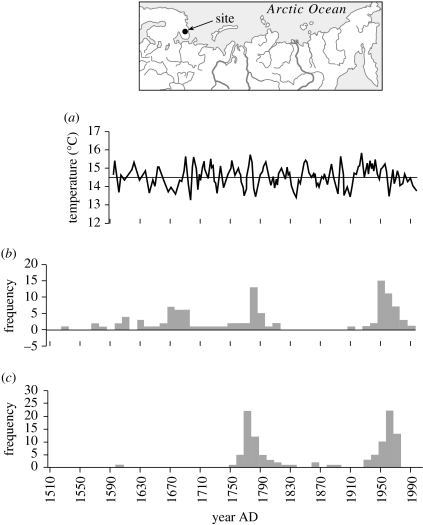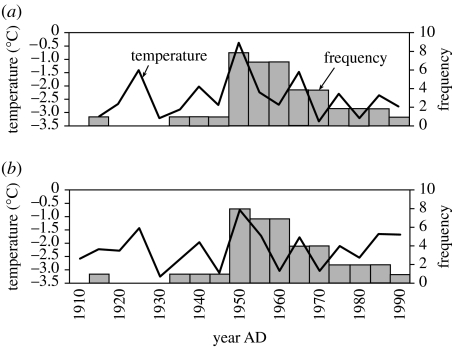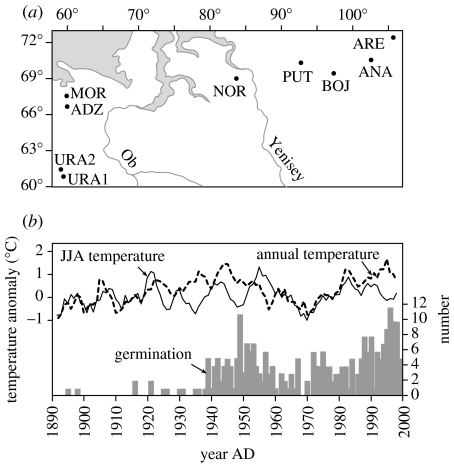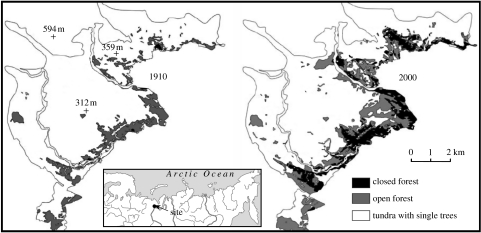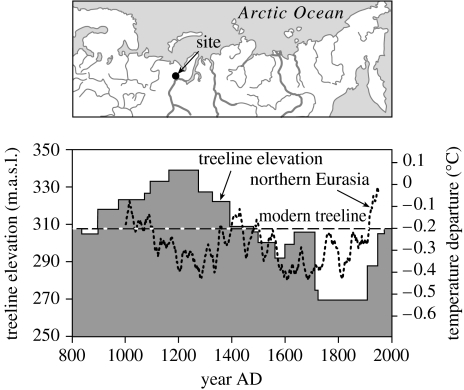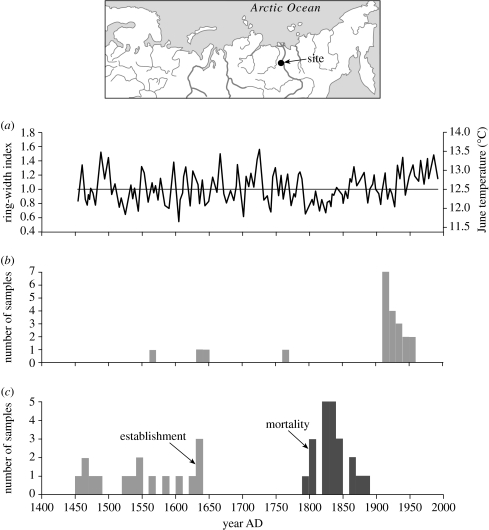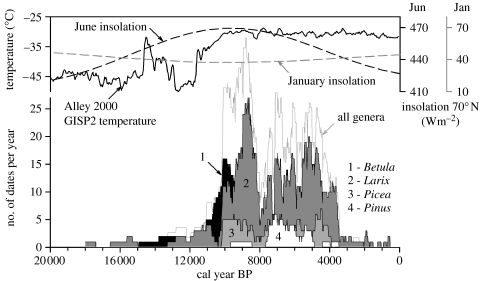Abstract
The Russian treeline is a dynamic ecotone typified by steep gradients in summer temperature and regionally variable gradients in albedo and heat flux. The location of the treeline is largely controlled by summer temperatures and growing season length. Temperatures have responded strongly to twentieth-century global warming and will display a magnified response to future warming. Dendroecological studies indicate enhanced conifer recruitment during the twentieth century. However, conifers have not yet recolonized many areas where trees were present during the Medieval Warm period (ca AD 800–1300) or the Holocene Thermal Maximum (HTM; ca 10 000–3000 years ago). Reconstruction of tree distributions during the HTM suggests that the future position of the treeline due to global warming may approximate its former Holocene maximum position. An increased dominance of evergreen tree species in the northern Siberian forests may be an important difference between past and future conditions. Based on the slow rates of treeline expansion observed during the twentieth century, the presence of steep climatic gradients associated with the current Arctic coastline and the prevalence of organic soils, it is possible that rates of treeline expansion will be regionally variable and transient forest communities with species abundances different from today's may develop.
Keywords: Arctic, Eurasia, Holocene, boreal forest, treeline, climate change
1. Introduction
Climate model experiments suggest that temperature increases due to global warming should be particularly pronounced in northern high latitudes such as the Eurasian treeline zone (Intergovernmental Panel on Climate Change 2001, 2007; Arctic Climate Impact Assessment 2004). In turn, increased temperatures will produce a northward extension of boreal forest into areas now occupied by tundra (Arctic Climate Impact Assessment 2004). Such a northward extension of the boreal forest would serve to decrease high-latitude albedo and provide a positive feedback, further enhancing global warming (Bonan et al. 1995; Woodward et al. 1998; Levis et al. 1999, 2000; Foley et al. 2003). The change in albedo could be particularly large in northern Siberia where it is possible that the evergreen conifers will become more important at the expense of deciduous species (Arctic Climate Impact Assessment 2004). Instrumental climate data and palaeoclimatological records indicate that the northern high latitudes have been experiencing a general pattern of increasing temperatures for more than a century, with particularly sharp increases in the past few decades (Overpeck et al. 1997; Hansen et al. 1999; Briffa et al. 2001; Lugina et al. 2006). The projected changes in temperature and vegetation in the Eurasian treeline zone, coupled with the temperature increases already experienced, raise several important questions. First, are tree populations at the treeline already responding to recent warming? Second, will the anticipated extension of boreal forest due to global warming exceed the limits of past forest expansion that occurred during earlier Holocene warm periods? Third, how quickly is boreal forest likely to expand northward onto the tundra in response to increased temperatures?
In this paper we examine the northern treeline zone of Eurasia with an emphasis on the region encompassed within the Russian Federation. We focus on insights regarding the dynamical nature of the treeline zone provided by the analysis of past changes in treeline reconstructed using tree rings and radiocarbon-dated subfossil wood. These retrospective approaches can be critical to anticipating future treeline response (Payette et al. 1989, 2002). Although not reviewed here, similar studies from adjacent Fennoscandia have a long history and are available from a number of sources (e.g. Eronen 1979; Eronen & Huttunen 1987, 1993; Vorren et al. 1993; Zackrisson et al. 1995; Kullman 1996, 1998a,b, 2002; Kullman & Englemark 1997; Kullman & Kjällgren 2000).
To begin, we outline the present climate–treeline relations across northern Eurasia. We then present evidence that temperature increases over the past century are already producing demonstrable changes in the population density of trees, but these changes have not yet generated an extension of conifer species' limits to or beyond the former positions occupied during the Medieval Warm period (MWP: ca AD 800–1300) or the Holocene Thermal Maximum treeline extension (HTM: broadly taken here to be ca 10 000–3000 years ago). We compare the reconstructed position of the treeline during the HTM with the projected future displacement of the treeline due to global warming. The comparison suggests that in northern Eurasia the future northern limits of boreal forest will generally coincide with the HTM limits. However, the projected dominance of northern forests in Siberia by evergreen conifers rather than larch may be an important difference between past and future treeline zone conditions. Finally, we examine the northward expansion of boreal forest during the initiation of the HTM and caution that, although the treeline zone is clearly a climatically sensitive and dynamic ecotone, future rates and patterns of northern forest expansion in some regions could be more constrained than in the Early Holocene due to the current proximity of the coastline and edaphic factors related to deep organic soils that have developed over the Holocene.
2. The northern Russian treeline zone and present climate
The northern treeline zone of Eurasia is a broad ecotone across which continuous boreal forest gives way to increasingly scattered fragments of forest and smaller individual trees. This transitional vegetation zone is often referred to as forest-tundra. Eventually the vegetation is dominated by treeless tundra. The latitudinal extent of this ecotone can range from a few kilometres to over a hundred kilometres. Locally, increasing elevation in hilly or mountainous terrain also leads to the restriction of tree species from higher sites in the treeline zone. Coniferous species at their northernmost limits often grow as scattered dwarf trees or contorted krummholz (figure 1). The current northern treeline zone in Eurasia runs roughly parallel to the Arctic coast for over 5500 km from Fennoscandia through eastern Siberia (figure 2). The treeline lies generally between 60° and 70° N latitude and extends northward to 73° N in the Taimyr Peninsula region of central Siberia, a location that represents the world's northernmost extension of the boreal forest. In Europe, the dominant conifers at or near the treeline include Pinus sylvestris L. (scots pine), Picea abies (L.) Karst. and Picea obovata Ledeb. (Norway and Russian spruce) and Larix sibirica Ledeb. (Siberian larch). In northern Asia, the dominant conifers at or near the treeline include larches (L. sibirica and Larix dahurica Turcz. ex Trautv.), Pinus sibirica Du Tour (Siberian pine) and Pinus pumila (Pall.) Regel (stone pine). Broadleaf trees such as Betula (birch) and Populus (poplar) can also be found in the Eurasian treeline zone. In Fennoscandia, the northern treeline is formed by Betula pubescens ssp. czerepanovii (Orlova) Hamet-Ahti which grows beyond the limits of P. sylvestris.
Figure 1.
(a) Dwarf and krummholz Larix dahurica at the treeline near the Lena Delta of eastern Siberia, (b) subfossil wood from trees that grew on uplands near the Lean River Delta during the fifteenth through seventeenth centuries and (c) a mid-Holocene Larix stump preserved on the tundra of western Taimyr Peninsula of central Siberia (all photos © Glen M. MacDonald and used with permission).
Figure 2.
The northern Eurasian treeline zone and mean monthly surface air temperatures for (a) July and (b) January (mapped using 1968–1996 NCEP data from NOAA Earth System Research Laboratory (http://www.cdc.noaa.gov/PublicData/)).
Based upon a broad range of studies and syntheses (Grace 1990; Stevens & Fox 1991; Juntilla & Nilsen 1993; James et al. 1994; Körner 1998; Sveinbjörnsson 2000; Grace et al. 2002; Kaplan et al. 2003), several generalizations can be made about climate–treeline relations. Cool growing-season temperatures coupled with a short growing season appear to be a major reason why trees do not grow further north in the Arctic. Air and soil temperatures are too cool and the growing season is too short for trees to conduct adequate photosynthesis and/or to use the glucose produced by photosynthesis to consistently meet growth and reproductive requirements. Rates of photosynthesis and respiration decline between 20 and 5°C. Of particular importance, the rate of photosynthate use displays a strong response to temperature declines within this temperature range. Physiological studies suggest that rates of carbon assimilation for Eurasian conifers are particularly sensitive to temperature in the early part of the growth season. Slight warming in the spring period can produce strong increases in annual carbon assimilation. The threshold for conifer tissue growth appears to lie between 3 and 10°C, and cool growing-season temperatures limit meristem activity and growth. Cool soil conditions in the growing-season impact on the availability of nitrogen and decrease growth. Shading by trees can accentuate soil cooling and serve as a negative feedback to forest development on cold sites. Prolonged minimum temperatures greater than 6°C are generally required for bud formation and other aspects of reproductive development. Successful sexual reproduction can be rare for the dwarf krummholz trees that typify the species limits for conifers, and local propagation is often by vegetative layering. Although growing season conditions are the most important factor for determining the general northern limits of forest, winter temperatures can limit locally the growth or survival of some treeline species such as P. sylvestris in certain settings. Tree growth and survival can also be affected by winter season damage to buds and needles by abrasive blowing snow and ice.
In northern Eurasia the treeline zone corresponds to where average July temperatures decline to 12.5–10.0°C (figure 2) and growing degree days drop below 800 (Kaplan et al. 2003). There is no similar general relationship between the location of the treeline and winter temperatures (figure 2), reinforcing the dominant role of growing season conditions in determining the limits of tree growth over most of northern Eurasia. For example, average January temperatures range from −10 to −15°C at the treeline in northwestern Europe to below −30°C in some regions of central Siberia (figure 2). However, there is a general correspondence between dominance by the winter-deciduous conifer genus, Larix, in Siberia and the cold winter temperatures that typify that region compared to the west. The treeline also roughly corresponds to the median July position of the Arctic frontal zone (Krebs & Barry 1970). Areas north of this frontal boundary are dominated by cold and dry polar air masses even during the summer. Finally, the proximity of the treeline zone to the coastline of the Arctic Ocean imposes a steep temperature gradient across the region of the treeline (figure 2). Thus, the geographical position of the Eurasian treeline zone is controlled by a climatic gradient in summer temperatures and the length of the growing season that is related to general latitudinal patterns of decreasing northern insolation, general atmospheric circulation and the location of the Arctic coastline.
3. The northern treeline zone and climate change
The presence or absence of boreal forest at higher latitudes can have a significant impact on climate. Thus, changes in the geographical position of the treeline may provide feedbacks to global warming. The relatively dark canopy of the boreal forest can produce an albedo that is 25–50% less than that of northern tundra (Monteith 1975; Bonan et al. 1995). Over the course of the year these differences are amplified in spring and autumn when the snow-covered tundra reflects a large amount of incoming short-wave radiation. The average annual albedo over tundra regions can exceed 0.4 while areas of continuous forest in the boreal interior and southern regions have values of 0.2–0.3 (figure 3). The difference in albedo across the treeline is most pronounced in northern Europe where evergreen pines and spruce are dominant in the northern boreal forest and becomes less pronounced in Siberia where deciduous larch trees dominate the northern forest (figure 3). In addition, the western Siberian lowlands are dominated by deep organic soils with more open and scattered tree cover extending well south of the treeline zone (Sheng et al. 2004).
Figure 3.
Eurasian treeline and average land-surface albedo (albedo based on MODIS imagery from NASA Visible Earth Library http://visibleearth.nasa.gov/).
As a result of differences in albedo and surface roughness, the boreal regions are preferentially warmed and have a higher sensible heat flux than tundra regions (Hare & Ritchie 1972; Lafleur et al. 1992; Pielke & Vidale 1995). The difference in heating between some boreal and tundra sites has been shown to be as high as 50 W m−2 (Pielke & Vidale 1995). The enhanced warming of the darker forest results in a greater sensible heat flow from forested regions. During the warm season of June–September, the long-wave flux in the interior boreal forest regions of Eurasia averages over 60 W m−2 and falls below 50 W m−2 in the tundra regions (figure 4). The open forests and wetter surfaces of the peatland-dominated western Siberian lowlands region provide an exception to this general correspondence (figure 4). In northern Eurasia, the difference in long-wave flow is enhanced by the location of the cold Arctic Ocean immediately adjacent to the tundra zone (figure 4). There is a steep thermal gradient between the warmer forest and the colder tundra and Arctic Ocean during the summer (figure 2), and this probably helps to anchor the summer position of the Arctic Front along the treeline zone (Pielke & Vidale 1995).
Figure 4.
Average June–September surface long-wave radiation flux in W m−2 (mapped using 1968–1996 NCEP data from NOAA Earth System Research Laboratory (http://www.cdc.noaa.gov/PublicData/)).
Based upon climate model experiments, the boreal treeline is considered a key centre of action for positive feedbacks between climate warming and vegetation response (Foley et al. 1998). A significant northward movement of the boreal forest, with its relatively low albedo and resulting replacement of higher albedo tundra, can produce a significant increase in regional and global temperatures (Foley et al. 1994, 1998, 2003; Bonan et al. 1995; TEMPO 1996; Woodward et al. 1998; Levis et al. 1999, 2000). Although the exact magnitude of that warming remains uncertain, in the high latitudes it may be as high as 4°C in spring and 1°C in other seasons should forests in North America and Eurasia advance to the Arctic coastline (Foley et al. 1994).
Instrumental records of climate warming over the past 120 years indicate that the northern Eurasian treeline zone displays strong response to general hemispheric and global temperature increases (Lugina et al. 2006). Annual and summer (June–August) temperatures have generally increased over the past 120 years with strong warming in recent decades (figure 5). A spatial analysis of annual trends indicates that the northern Eurasian treeline zone has experienced particularly marked increases in annual temperature over the past five decades (Hansen et al. 1999, 2006). Annual heating has been exceptionally strong in central Siberia (figure 5). In northern Eurasia the recent heating trend since the 1970s has been most strongly expressed in spring (March–May) with strong heating also apparent in autumn and winter. A summer (June–August) warming trend is apparent in eastern Siberia, but not in other parts of northern Eurasia (Rigor et al. 2000).
Figure 5.
Northern Hemisphere (a) annual and (b) summer (June–August) surface temperature trends from 1880 to 2005 by latitudinal band (adapted from Lugina et al. (2006)) and (c) map of change in annual surface temperature from 1955 to 2005 (Hansen et al. 2006).
Palaeoclimatic records for the past 1000 years provide evidence of longer-term temperature variations that would be expected to impact on the northern treeline zone (e.g. Overpeck et al. 1997; Briffa & Osborn 1999; Mann et al. 1999, 2003; Briffa 2000; Briffa et al. 2001). Although many of these temperature reconstructions are based entirely upon analysis of tree-ring records from northern latitudes, and could arguably present circular arguments by which changes in the radial growth of trees at the treeline are used to infer temperature changes that affect tree growth at the treeline, other records are synthetic in nature and incorporate temperature proxies other than northern tree rings (e.g. Overpeck et al. 1997; Mann et al. 1999, 2003). Most of the available palaeotemperature records, and a number of climate model simulations, for the past 1000 years provide a generally similar pattern (Mann et al. 2003; Jones & Mann 2004). The millennial length temperature estimates are often subdivided into three periods. From AD 1000 to ca 1400 there is evidence for generally warm conditions during the Late Medieval period (figure 6). This MWP is followed by the generally cool conditions of the Little Ice Age (LIA) which persist until ca AD 1880. The late nineteenth and twentieth centuries are characterized by generally increasing temperatures that in recent decades appear to have exceeded those experienced during the MWP (figure 6). Within these three broad periods, there is evidence of additional shorter-term climatic variability including a widespread period of warming during the mid-through late eighteenth century. The MWP, relative to the LIA, was typified by both increased solar insolation and decreased volcanic activity (Crowley 2000; Goosse et al. 2006). The prolonged and substantial warming of the Eurasian Arctic in the recent period probably reflects both of these natural factors and the additional radiative forcing provided by high levels of anthropogenic greenhouse gases (Overpeck et al. 1997; Crowley 2000; Goosse et al. 2006).
Figure 6.
Northern Hemisphere (Mann et al. 1999), Arctic (Overpeck et al. 1997) and northern Eurasian (Briffa & Osborn 1999; Briffa 2000) summer surface-temperature trends over the past 1000 years (adapted from Overpeck et al. 1997; Briffa & Osborn 1999; Mann et al. 1999; Briffa 2000 available at http://www.ncdc.noaa.gov/palaeo/pubs/briffa2001/briffa2001.html).
Projections of future surface temperatures (AD 2090–2100) in northern Eurasia due to increasing greenhouse gases suggest a rise in annual temperatures of 4–6°C, with summer (June–August) temperatures increasing by 2–3°C (Arctic Climate Impact Assessment 2004; Intergovernmental Panel on Climate Change 2007). The anticipated result of this warming is a northward extension of the boreal forest so that most of northern Eurasia to the Arctic coastline will be forested (figure 7). Such a displacement would produce decreased albedo, greater long-wave heat fluxes and an even sharper thermal gradient along the Arctic coastline. One particularly important facet of the vegetation projection (Arctic Climate Impact Assessment 2004) is that it predicts a dominance of evergreen boreal forest in much of northern Siberia. This region is now dominated by deciduous Larix forest. At present, the western boreal forest in European Russia has a lower albedo and greater reflectance contrast with the tundra than the eastern boreal forest in Siberia (figure 3). A shift to evergreen boreal forest in northeastern Siberia would amplify the change in albedo caused by future forest expansion.
Figure 7.
Projected position of the treeline in late twenty-first century (Arctic Climate Impact Assessment 2004), current northern limits for the trees (a) Betula, (b) Larix and (c) Picea, HTM northern limits of the same genera based on radiocarbon-dated subfossil wood and the location of the Early Holocene Eurasian coastline (MacDonald et al. 2000b).
4. Recent warming and changes at the treeline
Has the pattern of recent warming over the late nineteenth and the twentieth centuries caused significant changes in the density of trees at the treeline and/or an extension of the geographical location of the treeline? Dendroecological (tree-ring) records of tree demography and past treeline position are available from several sites along the treeline zone of northern Russia. Determining the ages of stems using tree rings allows for establishment/survivorship histories to be constructed for the current tree populations at the treeline. In some cases, cross-dating of dead wood allows for the reconstruction of mortality patterns and of past extensions of the treeline. In many cases, the dendroecological records of establishment and mortality provide a precision that is less than annual, ranging from 5 to 10 years in terms of uncertainty for both establishment and mortality of individual stems. In addition, it is difficult to determine if past increases in recruitment reflect increased establishment rates due to enhanced seed production and success in germination, or if past population increases reflect enhanced survivorship due to decreased mortality of recently established recruits. In the cases of the studies reviewed below, much of the research was conducted on hilly to mountainous sites in the northern treeline zone where the gradients between abundant trees and tree species' limits were compressed by elevational changes.
On the Kola Peninsula, a study by Gervais & MacDonald (2000) examined P. sylvestris near its northern range limits. The trees were distributed on a slight elevational gradient. Trees were present at the base of the slope but absent from the upland. The results demonstrate a pronounced peak in recruits from the mid-twentieth century (figure 8). The increase in recruitment during the twentieth century appears related to the increased length of the growing season as evidenced by increased temperatures during April and September (figure 9). Although there was little establishment/survivorship at the site during the mid- to late nineteenth century, there was an earlier period of enhanced recruitment during the late eighteenth century that corresponds with generally warmer hemispheric and Arctic temperatures (figure 6). Locally, there were periods of prolonged cool summer temperatures in the early and late nineteenth century (figure 8). In both the Kola and the adjacent northern Fennoscandia, there is evidence for the continuous presence of P. sylvestris trees at their current northern range limits for at least several hundred years prior to the twentieth-century warming. In addition, there are similar patterns of enhanced recruitment in the eighteenth and twentieth centuries in both regions (figure 8).
Figure 8.
Tree-ring-based reconstruction of (a) July temperatures and (b) P. sylvestris recruitment at the treeline on the Kola Peninsula of northern European Russia (adapted from Gervais & MacDonald 2000). (c) Recruitment data from P. sylvestris at the treeline in northern Sweden (Zackrisson et al. 1995).
Figure 9.
Pinus sylvestris recruitment at the treeline on the Kola Peninsula and variations in (a) April and (b) September temperature (Gervais & MacDonald 2000).
On the Khibiny uplands located in the central Kola Peninsula, radiocarbon dates from Pinus stumps and forest palaeosols indicate that the treeline was located 100–140 m higher in elevation than today during the MWP (between ca AD 600 and 1300 in this case). Forest has yet to recolonize these elevations (Kremenetski et al. 2004).
Recently, Esper & Schweingruber (2004) conducted a detailed survey of recent recruitment of P. sibirica, P. obovata, L. sibirica and Larix cajanderi at nine sites located in northeastern European Russia and central Siberia (figure 10). They found evidence for two clear phases of population increase, the first extending from approximately 1940 to 1960 and the second from the 1970s to 2000. These population growth phases appear to be linked to increases in annual and summer temperatures (figure 10). The study is important in showing a very widespread pulse of enhanced tree recruitment over the twentieth century. In addition, the study found a parallel pattern of increasing vertical growth in trees that formerly had suppressed growth. These results document a geographically extensive change in stand density and structure in response to recent warming in central northern Eurasia.
Figure 10.
(a) Sampling sites for P. sibirica, P. obovata, L. sibirica and L. cajanderi recruitment history for the twentieth century and (b) derived recruitment history and dendroclimatologically reconstructed annual and summer (June–August) temperature anomalies for northern central Eurasia (Esper & Schweingruber 2004).
In a study of the treeline at the northern end of the Polar Urals, Shiyatov et al. (2005) combined the analysis of modern vegetation and stand demography with historical photographic records extending back to the 1910s to reconstruct spatial changes in the L. sibirica–P. obovata treeline over the past century (figure 11). They found that there had been clear upslope movement of closed forest, open forest and sparse tree cover into regions formerly dominated by tundra with scattered individual trees. In some cases, closed forest and open forest had extended over a kilometre beyond their 1910 limits. A combination of warmer temperatures, an extended growing season (particularly in May) and moister conditions are probably responsible for the advance of forest. Although the extension of forest cover was appreciable, it should be borne in mind that this development of denser forest cover occurred in a region where sparse forest or scattered individual trees were generally already present. These pre-existing trees would have served as inoculation foci allowing for rapid density changes in the forest (MacDonald et al. 1993). Shiyatov et al. (2005) concluded that seed availability promoted rapid infilling of areas with sparse forest cover, but that the poor transport of seeds upslope away from parent stands hindered establishment beyond the limits of trees. Larix releases seeds in July and they are typically not transported far in the absence of smooth snowcover.
Figure 11.
Spatial changes in L. sibirica–P. obovata forest distribution from the 1910s to 2000 at an upland treeline site in the northern Polar Urals of western Siberia (Shiyatov et al. 2005).
A longer reconstruction of past treeline elevation in the northern Polar Urals based upon cross-dating of abundant Larix dead wood suggests that over the past 1200 years there have been significant (60–80 m) and prolonged elevation shifts in the regional treeline (Shiyatov 1993, 1995, 2003; Mazepa 2005). The treeline was at its highest elevation during the MWP between ca AD 900 and 1300 when it reached 340 m (figure 12). Following that time the treeline descended to approximately 270 m during the LIA and then ascended to its present elevation of approximately 310 m during the recent warming of the late nineteenth and twentieth centuries. As of yet, the treeline has not been reached or exceeded its limits from the MWP, probably owing to poor seed dispersal by Larix (Shiyatov 2003).
Figure 12.
Comparison of northern Eurasia summer temperature trends (Briffa 2000) with Larix treeline advances and retreats in the northern Polar Urals of western Siberia (Shiyatov 2003) over the past 1000 years.
An upland treeline site (figure 13) near the Lena River Delta in eastern Siberia contained living L. dahurica in the lowlands and abundant dead wood on the adjacent uplands, suggesting a once higher treeline (MacDonald et al. 1998; figure 1b). The age structure of the living trees in the lowlands indicates a period of enhanced recruitment in the early to mid-twentieth century, but with some older individuals dating back to the sixteenth century (figure 13). Now-dead trees on the uplands established during the fifteenth through mid-seventeenth centuries and then experienced die-off during the nineteenth century. The episode of tree die-off on the uplands corresponds with summer cooling during the LIA. There was particularly severe local cooling in the late eighteenth and early nineteenth centuries (figure 13). The increased recruitment of the twentieth century corresponds generally with the prolonged warming of this period (figure 13). The peak in warming appears to follow the peak in stand age, perhaps reflecting the importance of warmer conditions to survival of recently germinated trees.
Figure 13.
Dendroclimatologically reconstructed (a) June temperatures and (b) L. dahurica establishment (living lowland tree establishment) and (c) establishment and mortality (dead upland trees) at a treeline site near the Lena River delta in eastern Siberia (MacDonald et al. 1998).
Although studies of treeline dynamics in northern Russia remain sparse relative to the geographical expanse of the region, some preliminary conclusions can be drawn from the available data in terms of recent warming and treeline response. First, the twentieth century has been typified by widespread enhanced recruitment at the treeline, but negligible range extension of tree species at the sites studied. Second, prior to the recent upsurge in recruitment, cooling during the LIA negatively impacted on tree population densities and caused range contraction. Third, in many cases, the enhanced recruitment and small-range adjustments experienced in the twentieth century have not yet been of sufficient magnitude to compensate for the range contraction during the LIA. Thus, some areas that were forested or supported sparse trees during the MWP remain treeless at present. In effect, at the Russian sites studied, the impact of twentieth century warming has not yet compensated fully for the mortality and range constriction caused by the cold temperatures of the LIA. These results are similar to observations in some other northern treeline regions such as uplands in eastern Quebec and interior Labrador where Picea mariana (P. Mill.) B. S. P. and Picea glauca (Moench) Voss trees remain below their pre-LIA limits despite recent warming (Gamache & Payette 2005; Payette 2007).
5. Anticipated future treeline zone changes in the context of Holocene palaeoecological records
If the northern treeline zone shifts significantly northward in the future due to global warming, will this situation be unprecedented relative to shifts observed in the treeline over the course of the Holocene? The northern tundra zone of continental Eurasia contains an important fossil archive related to the past distribution of tree species during the Late Pleistocene and Holocene. From Fennoscandia to eastern Siberia, hundreds of wood macro- and megafossils of Pinus, Picea, Larix and Betula trees have been found in locations north of the modern range limits of these genera (figure 1c). In northern Russia such samples, including bark, cones, needles and large logs, have been discovered on the tundra surface and in peats, alluvial deposits, colluvial deposits and lake sediments (e.g. Khotinskiy 1984; Kremenetski et al. 1998; Hantexmirov & Shiyatov 1999, 2002; MacDonald et al. 2000a,b). These macro- and megafossils can be identified to genera and radiocarbon dated to provide spatially precise estimates of the presence of tree genera in areas that are devoid of trees today (MacDonald 2006).
The expansion of coniferous tree species during the period of increased summer insolation and high-latitude warming of the Late Pleistocene and Early Holocene (figure 14) is reflected in the frequency distribution of the calibrated ages (2σ-precision age ranges: Stuiver & Reimer 1993; Reimer et al. 2004) of 349 radiocarbon-dated tree fossils (Kremenetski et al. 1998; MacDonald et al. 2000a,b). The ages of many of the fossils from north of the modern Eurasian treeline (figure 14) cluster between 10 000 and 3500 cal. yr BP (calendar years before AD 1950). Taxa-specific patterns suggest the densest development of forest beyond the modern treeline occurred in the Early Holocene for Betula and Larix (typical of central and eastern Siberia) with later peaks in density for Picea and Pinus at treeline sites to the west (figures 7 and 14). An Early Holocene maximum in the geographical extension of Larix-dominated forest in northern Siberia is also evident in a detailed study by Hantemirov & Shiyatov (1999, 2002) of treeline movement on the Yamal Peninsula. Based on 53 radiocarbon-dated megafossils of Larix, they concluded that a maximum northward extension of the Larix-dominated treeline occurred in the Early Holocene between 10 500 and 7400 years ago. The range limits of Larix was extended by at least 30 km north of its modern position during that time. Forest cover on the Yamal Peninsula has remained at its present northern limits over the past 3700 years.
Figure 14.
Comparison of the age distribution of radiocarbon-dated fossil remains of different tree genera from north of the present treeline (adapted from Kremenetski et al. (1998) and MacDonald et al. (2000a,b)), seasonal insolation patterns at 70° N (Berger & Loutre 1991) and reconstructed Greenland temperature from the GISP2 drilling project (Alley 2000).
Examination of the spatial distribution of megafossils of Larix, which typically forms the conifer treeline over much of northeastern Eurasia, indicates that during the broad period of 10 000–3500 cal. yr BP the northern boreal treeline was probably located up to 200 km north of its modern position (figure 7). The period of forest extension coincides with increased summer insolation and growing-season temperatures relative to modern conditions (figure 14) and is consistent with known climatic controls on northern tree species. The apparent maximum extension of the northern treeline during the Early and Mid-Holocene corresponds closely with the anticipated future northern limits of boreal forest due to global climate warming (figure 7). In regard to the geographical location of the treeline zone, the HTM in northern Eurasia may provide an analogue for expected future northern forest distribution resulting from increased greenhouse gases and associated global warming. However, the sparse numbers of Picea and Pinus megafossils from the Siberian treeline zone relative to Larix megafossils suggest that then, as now, this region was dominated by deciduous conifer forest, which contrasts to the projected future importance of evergreen conifer forest in the region. Larix was important in the Early Holocene treeline zone vegetation across northern Russia and fossils of the genus have even been reported from Fennoscandia where it did not occur naturally in the Late Holocene (Kullman 1998b). A dominance and potential westward range extension of this deciduous conifer genus is consistent with low winter and high summer insolation during the Early Holocene which would have promoted colder winters and increased seasonality at that time (figure 14).
6. Rates of treeline extension
How quickly will the current treeline zone shift northward in response to continued climate warming? The dendroecological studies of recent treeline history outlined in §4 demonstrate that the density of tree populations can respond very quickly to warming. Rates of infilling of forest where sparse trees already exist will be rapid. However, at the sites studied in Russia the rate of elevational or latitudinal expansion of tree species' distributional limits appears slower. Many areas which contained tree populations during the MWP have still not been recolonized despite the pronounced and prolonged warming over the twentieth and twenty-first centuries. Yet, these distances are relatively modest. These results contrast slightly with evidence from the Scandes Mountains of Sweden that shows that twentieth-century warming has produced an upslope movement of the species limits of trees such as P. abies and P. sylvestris of 120–375 m.a.s.l. (Kullman 2002). In these more maritime mountains, warmer summers, coupled with warmer winters and decreased snowcover, may have promoted these rapid extensions in the late twentieth century (Kullman 2002). Interestingly, Payette (2007) also found twentieth-century forest tree expansion, and colonization of pre-LIA limits was better in coastal Labrador than on uplands in the interior. In interior regions tree populations had failed to recolonize their former ranges. Much of the available evidence from dendrochronological studies of the response of trees to recent warming suggest the potential for decadal to centennial scale lags between future warming and the extension of the treeline to its ultimate northern position, but that the response may be regionally variable. As pointed out by Payette et al. (1989), the response of the treeline to climate warming is not straightforward and may be influenced by many factors including pre-existing vegetation.
The future position of the northern treeline will probably be similar to its past maximum extension and the expansion of the treeline in the Early Holocene (figures 7 and 14). The establishment of forest across northern Eurasia at the start of the Holocene represents both the expansion of tree populations from scattered glacial refugial populations in Siberia and the spread northward to recently deglaciated terrain in northern Russia and northern treeless areas adjacent to the Arctic coastline in northern Siberia (MacDonald et al. 2000b; Payette et al. 2002). The development of forest was a response to increasing summer temperatures related to increasing summer insolation (figure 14). The sharp warming that occurred at the higher latitudes at the end of the Younger Dryas Stadial (ca 13 000–12 000 cal. yr BP) coincides with a rapid increase in northern tree populations and their geographical expansion. The timing of maximum tree fossil abundance north of the modern treeline occurs close, although slightly lagged, in timing to the peak of summer insolation and the initial development of warm Holocene temperatures, as represented in the Greenland ice core record (figure 14). These results suggest a relatively rapid, although not completely synchronous, response of treeline forest in terms of density and location to increasing temperatures at the start of the Holocene. The rapid response of the treeline in northern Russia, particularly Siberia, may have been promoted by the proximity of glacial refugial tree populations (Payette et al. 2002). However, it also appears that the different tree genera reached their maxima during the Holocene at different rates. Betula had a rapid early peak followed by Larix and Picea. Pinus, dominant on the Kola Peninsula, appears to have lagged behind the other genera (figure 14). A relatively rapid colonization of higher elevations by tree species during the Early Holocene has also been reported from the Scandes Mountains of Sweden (Kullman 1998a,b). These results suggest that during the Early Holocene lags between warming and treeline extension over most of northern Russia may have been on a centennial scale, but did not span thousands of years. Given that northern conifers would typically reach reproductive age after 15–40 years, some lag between climate change and forest development is inevitable.
Attempts to use the Early Holocene expansion of the treeline as a model for future treeline advance are subject to important limitations. There are several major differences between the Early Holocene and anticipated future warming. First, during the Early Holocene summer insolation was at a maximum and winter insolation was lower than present (figure 14). In contrast, future global warming will probably see winters warming more dramatically than summers in the subarctic and arctic zones (Arctic Climate Impact Assessment 2004). Although summer conditions are closely correlated with treeline position, the expansion of the growing season due to the warmer spring and autumn conditions could be particularly conducive to increased carbon assimilation and resulting tree growth and reproduction. Warmer winters may also preferentially favour evergreen genera such as Pinus and Picea relative to Larix. Second, during the Late Pleistocene and Early Holocene sea levels were lower than today and the coastline of northern Eurasia, particularly in central and eastern Siberia, was located up to several hundred kilometres north of its modern location (figure 7). The steep thermal gradient and cold temperatures associated with the Arctic coastline would have been located much further north of the Early Holocene treeline than it will be for the anticipated future position of the treeline. In addition to the steep temperature gradient near the modern coast, the marine influence on soils can negatively impact tree establishment and growth (Crawford 2000).
Edaphic conditions were very different at the start of the Holocene than today. The often thick cover by organic soils that is found in many parts of the northern Eurasian treeline zone today was not present at that time (MacDonald et al. 2006) and seedbed conditions were more typical of mineral soils. Betula was the most rapidly expanding tree genus in the Late Glacial and Early Holocene, and its light winged seeds would have promoted rapid dispersal and range extension. Although the seeds of the common species Betula pendula Roth and B. pubescens Ehrh can also germinate well on moist Sphagnum surfaces and their seedlings require moist soils, they suffer high mortality if the surface is prone to drying and the young roots cannot reach the mineral soil (Kinnaird 1974). Similarly, P. sylvestris regeneration is typically extremely poor on organic soils that are prone to surface drying (Hille & den Ouden 2004). These establishment requirements may slow northward spread and population increases of Betula and P. sylvestris if soil conditions are relatively dry and on the thick organic soils that exist today.
Issues regarding the effects of moisture stress on established trees are also a concern in anticipating treeline response to climate warming. Recent research suggests that boreal trees at some northern boreal sites, including ones in northern Eurasia, may now be experiencing higher rates of stress to summer drought than earlier in the twentieth century (e.g. Briffa et al. 1998; Barber et al. 2000; Wilmking et al. 2005). Gamache & Payette (2005) deduced that drought and seedbed drying on tundra soils were probably an important factor slowing the expansion of P. mariana at the treeline in eastern Quebec despite recent climate warming.
In light of different climatic requirements, substrate preferences, current population distributions, years required to reach reproductive age, seed dispersal rates, and so on, and observations from the palaeoenvironmental record of species-specific responses to past climate change (figure 14), the differential response of treeline genera might also play out in different rates of expansion in the future. Kullman (1998a,b) has pointed out the unique tree species compositions that developed in the Scandes Mountains in the Early Holocene and their possible reflection of the unique environmental conditions at that time. Differential styles and rates of response to future warming could lead to the development of transient forest conditions at the treeline which may be unexpected and unprecedented today or during earlier periods in the Holocene.
Given the slow rate of northward forest extension observed thus far, coupled with the climatic, edaphic and ecological factors outlined above, it is difficult to envision that the anticipated northward forest expansion and development of new forest communities as projected by model experiments such as that presented in the Arctic Climate Impact Assessment (2004) would be completed by AD 2100. Developing a clearer understanding of the potential rate of response of the northern boreal forest and treeline zone is a critical area for research.
Acknowledgments
We thank the editors of this issue for their work in producing this collection. We also thank all the scientists, students and assistants from Russia, the United States, Canada and many other countries who have worked with us at diverse locations across northern Russia. Prof. Serge Payette and two anonymous reviewers provided their helpful comments on an earlier draft of the manuscript. The research was supported by grants from the Natural Sciences and Engineering Research Council of Canada (PACT Special Collaborative grant) and grants OPP-0352604, OPP-9818496 and ATM-9632926 from the National Science Foundation of the United States.
Footnotes
One contribution of 12 to a Theme Issue ‘The boreal forest and global change’.
References
- Alley R.B. The Younger Dryas cold interval as viewed from central Greenland. Quat. Sci. Rev. 2000;19:213–226. doi: 10.1016/S0277-3791(99)00062-1. [DOI] [Google Scholar]
- Arctic Climate Impact Assessment. Cambridge University Press; Cambridge, UK: 2004. Impacts of a warming Arctic: Arctic climate impact assessment. [Google Scholar]
- Barber V, Juday G.P, Finney B. Reduced growth of Alaska white spruce in the twentieth century from temperature-induced drought stress. Nature. 2000;405:668–672. doi: 10.1038/35015049. [DOI] [PubMed] [Google Scholar]
- Berger A, Loutre M.F. Insolation values for the climate of the last 10 million years. Quat. Sci. Rev. 1991;10:297–317. doi: 10.1016/0277-3791(91)90033-Q. [DOI] [Google Scholar]
- Bonan G.B, Chapin F.S, Thompson S.L. Boreal forest and tundra ecosystems as components of the climate system. Clim. Change. 1995;29:145–167. doi: 10.1007/BF01094014. [DOI] [Google Scholar]
- Briffa K.R. Annual climate variability in the Holocene: interpreting the message of ancient trees. Quat. Sci. Rev. 2000;19:87–105. doi: 10.1016/S0277-3791(99)00056-6. [DOI] [Google Scholar]
- Briffa K.R, Osborn T.J. Seeing the wood from the trees. Science. 1999;284:926–927. doi: 10.1126/science.284.5416.926. [DOI] [Google Scholar]
- Briffa K.R, Schweingruber F.H, Jones P.D, Osborn T.J, Shiyatov S.G, Vaganov E.A. Reduced sensitivity of recent tree-growth to temperature at high northern latitudes. Nature. 1998;391:678–682. doi: 10.1038/35596. [DOI] [Google Scholar]
- Briffa K.R, Osborn T.J, Schweingruber F.H, Harris I.C, Jones P.D, Shiyatov S.G, Vaganov E.A. Low-frequency temperature variations from a northern tree ring density network. J. Geophys. Res. 2001;106 D3:2929–2941. doi: 10.1029/2000JD900617. [DOI] [Google Scholar]
- Crawford R.M.M. Ecological hazards of oceanic environments. New Phytol. 2000;147:257–281. doi: 10.1046/j.1469-8137.2000.00705.x. [DOI] [Google Scholar]
- Crowley T.J. Causes of climate change over the past 1000 years. Science. 2000;289:270–277. doi: 10.1126/science.289.5477.270. [DOI] [PubMed] [Google Scholar]
- Eronen M. The retreat of pine forest in Finnish Lapland since the Holocene climatic optimum: a general discussion with radiocarbon evidence from subfossil pines. Fennia. 1979;157:93–114. [Google Scholar]
- Eronen M, Huttunen P. Radiocarbon dated subfossil pines from Finnish Lapland. Geogr. Ann. 1987;69:297–304. doi: 10.2307/521190. [DOI] [Google Scholar]
- Eronen M, Huttunen P. Pine megafossils as indicators of Holocene climatic changes in Fennoscandia. In: Frenzel B, editor. Oscillations of the alpine and polar tree limits in the Holocene. Palaoclimaforschung–palaeoclimate research. vol. 9. Gustav Fischer; Stuttgart, Germany: 1993. pp. 29–40. [Google Scholar]
- Esper J, Schweingruber F.H. Large-scale treeline changes recorded in Siberia. Geophys. Res. Lett. 2004;31:L06202. doi: 10.1029/2003GL019178. [DOI] [Google Scholar]
- Foley J, Kutzbach J.E, Coe M.T, Levis S. Feedbacks between climate and boreal forests during the Holocene epoch. Nature. 1994;371:52–54. doi: 10.1038/371052a0. [DOI] [Google Scholar]
- Foley J.A, Levis S, Prentice I.C, Pollard D, Thompson S.L. Coupling dynamic models of climate and vegetation. Global Change Biol. 1998;4:561–579. doi: 10.1046/j.1365-2486.1998.t01-1-00168.x. [DOI] [Google Scholar]
- Foley J.A, Costa M.H, Delire C, Ramankutty N, Snyder P. Green surprise? How terrestrial ecosystems could affect earth's climate. Front. Ecol. Environ. 2003;1:38–44. [Google Scholar]
- Gamache I, Payette S. Latitudinal response of subarctic tree lines to recent climate change in Eastern Canada. J. Biogeogr. 2005;32:849–862. doi: 10.1111/j.1365-2699.2004.01182.x. [DOI] [Google Scholar]
- Gervais B.R, MacDonald G.M. A 403-year record of July temperatures and treeline dynamics of Pinus sylvestris from the Kola Peninsula, northwest Russia. Arct. Antarct. Alp. Res. 2000;32:295–302. doi: 10.2307/1552528. [DOI] [Google Scholar]
- Goosse H, Arzel O, Luterbacher J, Mann M.E, Renssen H, Riedwyl N, Timmermann A, Xoplaki E, Wanner H. The origin of the European ‘Medieval Warm period’. Clim. Past. 2006;2:99–113. [Google Scholar]
- Grace J. Cuticular water loss unlikely to explain tree-line in Scotland. Oecologia. 1990;84:64–68. doi: 10.1007/BF00665596. [DOI] [PubMed] [Google Scholar]
- Grace J, Berninger F, Nagy L. Impacts of climate change on the tree line. Ann. Bot. 2002;90:537–544. doi: 10.1093/aob/mcf222. [DOI] [PMC free article] [PubMed] [Google Scholar]
- Hansen J, Ruedy R, Glascoe J, Sato M. GISS analysis of surface temperature change. J. Geophys. Res. 1999;104:30 997–31 022. doi: 10.1029/1999JD900835. [DOI] [Google Scholar]
- Hansen J, Ruedy R, Sato M, Lo K. NASA Goddard Institute for Space Studies; New York, NY: 2006. GISS surface temperature analysis global temperature trends: 2005 summation. See http://data.giss.nasa.gov/gistemp/2005/. [Google Scholar]
- Hantemirov R.M, Shiyatov S.G. Main stages of woody vegetation development in the Yamal Peninsula in the Holocene. Russ. J. Ecol. 1999;30:141–147. [Google Scholar]
- Hantemirov R.M, Shiyatov S.G. A continuous multimillennial ring-width chronology in Yamal, northwestern Siberia. Holocene. 2002;12:717–726. doi: 10.1191/0959683602hl585rp. [DOI] [Google Scholar]
- Hare F.K, Ritchie J.C. The boreal paleoclimates. Geogr. Rev. 1972;62:334–365. doi: 10.2307/213287. [DOI] [Google Scholar]
- Hille M, den Ouden J. Improved recruitment and early growth of Scots pine (Pinus sylvestris L.) seedlings after fire and soil scarification. Eur. J. For. Res. 2004;123:213–218. [Google Scholar]
- Intergovernmental Panel on Climate Change. Cambridge University Press; Cambridge, UK: 2001. Climate change 2001: the scientific basis. [Google Scholar]
- Intergovernmental Panel on Climate Change. World Meteorological Organization; Geneva, Switzerland: 2007. Climate change 2007: the physical science basis summary for policymakers. [Google Scholar]
- James J, Grace J, Hoad S. Growth and photosynthesis of Pinus sylvestris at its altitudinal limit in Scotland. J. Ecol. 1994;82:297–306. doi: 10.2307/2261297. [DOI] [Google Scholar]
- Jones P.D, Mann M.E. Climate over past millennia. Rev. Geophys. 2004;42:RG2002. doi: 10.1029/2003RG000143. [DOI] [Google Scholar]
- Juntilla O, Nilsen J. Growth and development of northern forest trees as affected by temperature and light. In: Alden J, Mastrantonio J.L, Xdum S, editors. Forest development in cold climates. Plenum Press; New York, NY: 1993. pp. 43–57. [Google Scholar]
- Kaplan J.O, et al. Climate change and Arctic ecosystems. 2. Modeling, paleodata-model comparisons, and future projections. J. Geophys. Res. 2003;108:8171. doi: 10.1029/2002JD002559. [DOI] [Google Scholar]
- Khotinskiy N.A. Holocene vegetation history. In: Velichko A.A, editor. Late Quaternary environments of the Soviet Union. University of Minnesota Press; Minneapolis, MN: 1984. pp. 179–200. [Google Scholar]
- Kinnaird J.W. Effect of site conditions on the regeneration of birch (Betula pendula Roth and B. pubescens Ehrh.) J. Ecol. 1974;62:467–472. doi: 10.2307/2258992. [DOI] [Google Scholar]
- Körner C. A re-assessment of the high elevation treeline positions and their explanation. Oecologia. 1998;115:445–459. doi: 10.1007/s004420050540. [DOI] [PubMed] [Google Scholar]
- Krebs J.S, Barry R.G. The Arctic Front and the tundra–taiga boundary in Eurasia. Geogr. Rev. 1970;60:548–554. doi: 10.2307/213773. [DOI] [Google Scholar]
- Kremenetski C.V, Leopold D, Sulerzhitsky L, Hantemirov R. Holocene history of the northern range limit of some trees and shrubs in Russia. Arct. Alp. Res. 1998;30:317–333. doi: 10.2307/1552004. [DOI] [Google Scholar]
- Kremenetski K.V, Boettger T, MacDonald G.M, Vaschalova T, Sulerzhitsky L, Hiller A. Medieval climate warming and aridity as indicated by multiproxy evidence from the Kola Peninsula, Russia. Palaeogeogr. Palaeocl. 2004;209:113–125. doi: 10.1016/j.palaeo.2004.02.018. [DOI] [Google Scholar]
- Kullman L. Structural population dynamics of pine (Pinus sylvestris L.) during the past 500 years close to the tree limit in northern Sweden. Paleoclim. Res. 1996;20:75–82. [Google Scholar]
- Kullman L. Non-analogous tree flora in the Scandes Mountains, Sweden, during the Early Holocene: macrofossil evidence of rapid geographic spread and response to palaeoclimate. Boreas. 1998a;27:153–161. [Google Scholar]
- Kullman L. Palaeoecological, biogeographical and palaeoclimatological implications of Early Holocene immigration of Larix sibirica Ledeb. into the Scandes Mountains, Sweden. Global Ecol. Biogeogr. 1998b;7:181–188. doi: 10.2307/2997373. [DOI] [Google Scholar]
- Kullman L. Rapid recent range-margin rise of tree and shrub species in the Swedish Scandes. J. Ecol. 2002;90:68–77. doi: 10.1046/j.0022-0477.2001.00630.x. [DOI] [Google Scholar]
- Kullman L, Englemark O. Neoglacial climate control of subarctic Picea abies stand dynamics and range limits in northern Sweden. Arct. Alp. Res. 1997;29:315–362. doi: 10.2307/1552146. [DOI] [Google Scholar]
- Kullman L, Kjällgren L. A coherent postglacial tree-limit chronology (Pinus sylvestris L.) for the Swedish Scandes: aspects of paleoclimate and ‘recent warming’, based on megafossil evidence. Arct. Antarct. Alp. Res. 2000;32:419–428. doi: 10.2307/1552391. [DOI] [Google Scholar]
- Lafleur P.M, Rouse W.R, Carlson D. Energy balance differences and hydrologic impacts across the northern treeline. Int. J. Climatol. 1992;12:193–203. doi: 10.1002/joc.3370120208. [DOI] [Google Scholar]
- Levis S, Foley J.A, Pollard D. Potential high-latitude vegetation feedbacks on CO2-induced climate change. Geophys. Res. Lett. 1999;26:747–750. doi: 10.1029/1999GL900107. [DOI] [Google Scholar]
- Levis S, Foley J.A, Pollard D. Large-scale vegetation feedbacks on a doubled CO2 climate. J. Clim. 2000;13:1313–1325. doi: 10.1175/1520-0442(2000)013<1313:LSVFOA>2.0.CO;2. [DOI] [Google Scholar]
- Lugina, K. M., Groisman, P. Y., Vinnikov, K. Y., Koknaeva, V. V. & Speranskaya, N. A. 2006 Monthly surface air temperature time series area-averaged over the 30-degree latitudinal belts of the globe, 1881–2005. In Trends: a compendium of data on global change. Oak Ridge, TN: Carbon Dioxide Information Analysis Center, Oak Ridge National Laboratory, U.S. Department of Energy. See http://cdiac.ornl.gov/trends/temp/lugina/lugina.html.
- MacDonald G.M. Plant macrofossil methods and studies: megafossils. In: Elias S.A, editor. Encyclopedia of quaternary science. vol. 3. Elsevier; Oxford, UK: 2006. pp. 2298–2307. [Google Scholar]
- MacDonald G.M, Edwards T.W.D, Moser K.A, Pienitz R, Smol J.P. Rapid response of treeline vegetation and lakes to past climate warming. Nature. 1993;361:243–246. doi: 10.1038/361243a0. [DOI] [Google Scholar]
- MacDonald G.M, Case R.A, Szeicz J.M. A 538-year record of climate and treeline dynamics from the lower Lena River region of northern Siberia, Russia. Arct. Alp. Res. 1998;30:334–339. doi: 10.2307/1552005. [DOI] [Google Scholar]
- MacDonald G.M, Gervais B.R, Snyder J.A, Tarasov G.A, Borisova O.K. Radiocarbon dated Pinus sylvestris L. wood from beyond treeline on the Kola Peninsula, Russia. Holocene. 2000a;10:143–147. doi: 10.1191/095968300667807510. [DOI] [Google Scholar]
- MacDonald G.M, et al. Holocene treeline history and climate change across northern Eurasia. Quat. Res. 2000b;53:302–311. doi: 10.1006/qres.1999.2123. [DOI] [Google Scholar]
- MacDonald G.M, Beilman D.W, Kremenetski K.V, Sheng Y, Smith L.C, Velichko A.A. Rapid early development of the circumarctic peatlands and atmospheric CH4 and CO2 variations. Science. 2006;314:385–388. doi: 10.1126/science.1131722. [DOI] [PubMed] [Google Scholar]
- Mann M.E, Bradley R.S, Hughes M.K. Northern Hemisphere temperatures during the past millennium: inferences, uncertainties, and limitations. Geophys. Res. Lett. 1999;26:759–762. doi: 10.1029/1999GL900070. [DOI] [Google Scholar]
- Mann M.E, et al. On past temperatures and anomalous late 20th century warmth. Eos. 2003;84:256–258. [Google Scholar]
- Mazepa V.S. Stand density in the last millennium at the upper tree-line ecotone in the Polar Ural Mountains. Can. J. For. Res. 2005;35:2082–2091. doi: 10.1139/x05-111. [DOI] [Google Scholar]
- Monteith J.L. Case studies. vol. 2. Academic Press; New York, NY: 1975. Vegetation and the atmosphere. [Google Scholar]
- Overpeck J, et al. Arctic environmental change of the last four centuries. Science. 1997;278:1251–1256. doi: 10.1126/science.278.5341.1251. [DOI] [Google Scholar]
- Payette S. Contrasted dynamics of northern Labrador tree lines caused by climate change and migrational lag. Ecology. 2007;88:770–780. doi: 10.1890/06-0265. [DOI] [PubMed] [Google Scholar]
- Payette S, Filion L, Delwaide A, Bégin C. Reconstruction of tree-line vegetation response to long-term climate change. Nature. 1989;341:429–432. doi: 10.1038/341429a0. [DOI] [Google Scholar]
- Payette S, Eronen E, Jasinski P. The circumboreal tundra–taiga interface: Late Pleistocene and Holocene changes. Ambio Special Rep. 2002;12:15–22. [PubMed] [Google Scholar]
- Pielke R.A, Vidale P.L. The boreal forest and the polar front. J. Geophys. Res. 1995;100:25 755–25 758. doi: 10.1029/95JD02418. [DOI] [Google Scholar]
- Reimer P.J, et al. IntCal04—terrestrial radiocarbon age calibration, 0–26 cal kyr BP. Radiocarbon. 2004;46:1029–1058. [Google Scholar]
- Rigor I, Colony G, Roger L, Martin S. Variations in surface air temperature observations in the Arctic, 1979–97. J. Clim. 2000;13:896–914. doi: 10.1175/1520-0442(2000)013<0896:VISATO>2.0.CO;2. [DOI] [Google Scholar]
- Sheng Y, Smith L.C, MacDonald G.M, Kremenetski K.V, Frey K.E, Velichko A.A, Lee M, Beilman D.W, Dubinin P. A high-resolution GIS-based inventory of the west Siberian peat carbon pool. Global Biogeochem. Cycles. 2004;18:1–14. doi: 10.1029/2003GB002190. GB3004. [DOI] [Google Scholar]
- Shiyatov S.G. The upper timberline dynamics during the last 1100 years in the Polar Ural Mountains. In: Frenzel B, Eronen M, Glaser B, editors. Oscillations of the alpine and polar tree limits in the Holocene. Gustav Fischer Verlag; Stuttgart, Germany: 1993. pp. 195–203. [Google Scholar]
- Shiyatov S.G. Reconstruction of climate and the upper timberline dynamics since AD 745 by tree-ring data in the Polar Ural Mountains. In: Heikinheimo P, editor. Int. Conf. on Past, Present, and Future Climate: Proc. SILMU Conf., Helsinki, Finland, 22–25 August 1995. Publication of the Academy of Finland; Helsinki, Finland: 1995. pp. 144–147. 6/95. [Google Scholar]
- Shiyatov S.G. Rates of change in the upper treeline ecotone in the Polar Ural Mountains. Pages News. 2003;11:8–10. [Google Scholar]
- Shiyatov S.G, Terent'ev M.M, Fomin V.V. Spatiotemporal dynamics of forest-tundra communities in the Polar Urals. Russ. J. Ecol. 2005;36:69–75. doi: 10.1007/s11184-005-0051-9. [Transl. Ekologiya 2, 2005, 83–90.] [DOI] [Google Scholar]
- Stevens G.C, Fox J.F. The causes of treeline. Annu. Rev. Ecol. Syst. 1991;22:177–191. doi: 10.1146/annurev.es.22.110191.001141. [DOI] [Google Scholar]
- Stuiver M, Reimer P.J. Extended 14C data base and revised Calib 3.0 14C age calibration program. Radiocarbon. 1993;35:215–230. [Google Scholar]
- Sveinbjörnsson B. North American and European treelines: external forces and internal processes controlling position. Ambio. 2000;29:388–395. doi: 10.1639/0044-7447(2000)029[0388:NAAETE]2.0.CO;2. [DOI] [Google Scholar]
- Testing Earth System Models with Paleo-Observations (TEMPO) Members Kutzbach J.E, Bartlein P.J, Foley J.A, Harrison S.P, Hostetler S, Liu Z, Prentice I.C, Webb T., III Potential role of vegetation feedback in the climate sensitivity of high-latitude regions: a case study at 6000 years B.P. Global Biogeochem. Cycles. 1996;10:727–736. doi: 10.1029/96GB02690. [DOI] [Google Scholar]
- Vorren K.D, Jenson C, Mook R, Morkved B, Thun T. Holocene timberlines and climate in north Norway—an interdisciplinary approach. In: Frenzel B, editor. Oscillations of the Alpine and Polar tree limits in the Holocene. Palaoclimaforschung—palaeoclimate research. vol. 9. Gustav Fischer; Stutgart, Germany: 1993. pp. 115–126. [Google Scholar]
- Wilmking M, D'Arrigo R, Jacoby G.C, Juday G.P. Increased temperature sensitivity and divergent growth trends in circumpolar boreal forest. Geophys. Res. Lett. 2005;32:L15 715. doi: 10.1029/2005GL023331. [DOI] [Google Scholar]
- Woodward F.I, Lomas M.R, Betts R.A. Vegetation–climate feedbacks in a greenhouse world. Phil. Trans. R. Soc. B. 1998;353:29–38. doi: 10.1098/rstb.1998.0188. [DOI] [Google Scholar]
- Zackrisson O, Nilsson M.-C, Steijlen I, Hörnberg G. Regeneration pulses and climate–vegetation interactions in nonpyrogenic boreal Scots pine stands. J. Ecol. 1995;83:469–483. doi: 10.2307/2261600. [DOI] [Google Scholar]



